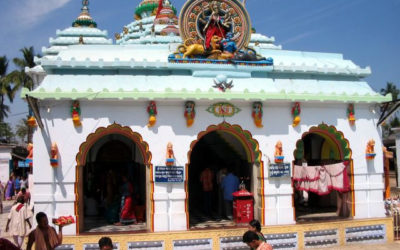Having grown up in an agraharam house, I have a fascination for traditional lifestyle. And it is disheartening to see concrete structures replacing vintage houses in the villages. On a recent trip, I happened to visit a beautiful village Brahmadesam, which is close to Mannarkoil. It is located 44.3 km west of Tirunelveli, near the Mundanthurai Tiger Reserve and Ambasamudram. As I passed through the village, I had a chance to visit the Kailasanathar temple, standing majestically in front of a brimming pond that was surrounded by an agraharam .
The seven-tier gopuram (that has intricate wooden pillars in the first few levels) welcomes the devotees. A huge Nandi, in the imperial Rajendra Chola style, occupies the façade of this shrine. It is claimed to be a monolith and amongst the largest in the area. One would notice a bell with attached rings and tongue carved into the ceiling. Moving on to the main deity – Kailasanatha – I admired the wooden ornamental arches put up perhaps by Vishwanatha Nayak, whose image is seen close by. The main shrine is simple and Lord Kailasanatha is seen in solitary splendour.
Around the shrine are niches of other deities. All of them date to the Raja Raja – Rajendra period and show Chola craftsmanship at its best. The yalis and the pillars with lion as the base are impeccably sculpted. The amman shrine is situated adjacent to the main shrine. The temple is associated with Surya but strangely has no enclosure for the navagraham. The temple doesn’t find mention in the Thevaram but inscriptions are aplenty.
Sadasiva Raya of the Vijayanagar dynasty gifted an entire village to the temple, and the village came to be known as Raja Raja Chaturvedimangalam, a Brahmadeya [a tax free land gifted to Brahmins] in Mulli Nadu. Another inscription mentions the gift from Veppangulam to fund festival expenses through the year. Many 16th Century inscriptions speak of gifts by local merchants. Another from the same time mentions one Ayyangara Nayaka, the son-in-law of Peddu Nayaka, who built the inner gopuram. Another long inscription dating back to 1,625 is seen at the entrance . It records the royal writ granted by Viswanatha Nayaka through which the members of the five sub-divisions of artisans (Kanmalar) should not intermingle with each other. The temple authorities also declared the same for the benefit of their subordinates.
Coming out, we stopped at the magnificent Tiruvadirai mandapam built to perfection during the Nayak period. The elephants with warriors in the balustrades, the yali pillars and the elaborate pedestal within are all gems of 16th century art. From here one can also observe the military arrangements etched on the compound wall of the temple. The temple’s nellkuthupirai or the mandapam to process and store rice lies in a dilapidated condition.
The local priest Kumar, notwithstanding a meagre salary that is frequently delayed from the Government, is an enterprising man. Keen to restore the glory of the temple, he provides the required information. The second pontiff of the Kanchi Kamakoti Mutt was from this village. The Rig Veda patasala has now been turned into a school due to lack of students. But that has not diminished the spirit of the ghanapadigal living here, who recites the Vedic hymns with deep devotion.



0 Comments